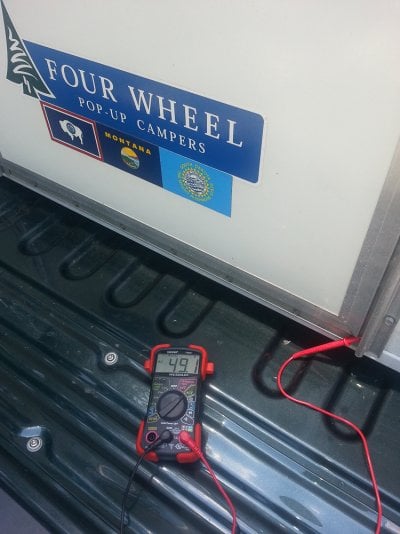TravelAmateurs
Advanced Member
I know much less than I'd like to about electrical systems so today was an important learning experience.
I pressed my face against the front wall of the camper to check my bumper spacing and felt like something bit me in the cheek. Plenty of bugs in VA this time of year so I didn't think much of it until I felt the same "bite" while grabbing the rear camper door (standing barefoot on the concrete driveway). Reached back towards the door slowly and the buzz confirmed I had been shocked. Unplugged the camper from shore power and stared confused at my soon to be home.
We had plugged into the same extension cord in the past but I realized the camper had always been on blocks on the ground. The camper was now sitting on a rubber mat in the bed of a truck with rubber tires, and I had created a human path for whatever charge was leaking into the frame. We also hadn't run the connection from the truck battery to the camper yet. Would that have mattered?
A little investigating confirmed that the extension cord was connected to an open ground outlet in the shed. Also, while using the open ground extension cord I shoved a big screwdriver into the dirt(for a ground) and tested the camper door with my multimeter to show 49 volts! Another earth ground source resulted in the same reading. Plugged into a properly grounded outlet and the camper door voltage was gone. Any further checks I need to do?
Found this site and the electrical safety series to be a good read for anyone interested:
http://www.noshockzone.org/rv-electrical-safety-part-iv-%E2%80%93-hot-skin/
Also, picked up these two gadgets as I'm sure I'll be plugging into some questionable outlets in the next year or so, and 13+ countries:
Outlet Tester
Non-Contact Voltage Tester
I pressed my face against the front wall of the camper to check my bumper spacing and felt like something bit me in the cheek. Plenty of bugs in VA this time of year so I didn't think much of it until I felt the same "bite" while grabbing the rear camper door (standing barefoot on the concrete driveway). Reached back towards the door slowly and the buzz confirmed I had been shocked. Unplugged the camper from shore power and stared confused at my soon to be home.
We had plugged into the same extension cord in the past but I realized the camper had always been on blocks on the ground. The camper was now sitting on a rubber mat in the bed of a truck with rubber tires, and I had created a human path for whatever charge was leaking into the frame. We also hadn't run the connection from the truck battery to the camper yet. Would that have mattered?
A little investigating confirmed that the extension cord was connected to an open ground outlet in the shed. Also, while using the open ground extension cord I shoved a big screwdriver into the dirt(for a ground) and tested the camper door with my multimeter to show 49 volts! Another earth ground source resulted in the same reading. Plugged into a properly grounded outlet and the camper door voltage was gone. Any further checks I need to do?
Found this site and the electrical safety series to be a good read for anyone interested:
http://www.noshockzone.org/rv-electrical-safety-part-iv-%E2%80%93-hot-skin/
Also, picked up these two gadgets as I'm sure I'll be plugging into some questionable outlets in the next year or so, and 13+ countries:
Outlet Tester
Non-Contact Voltage Tester


